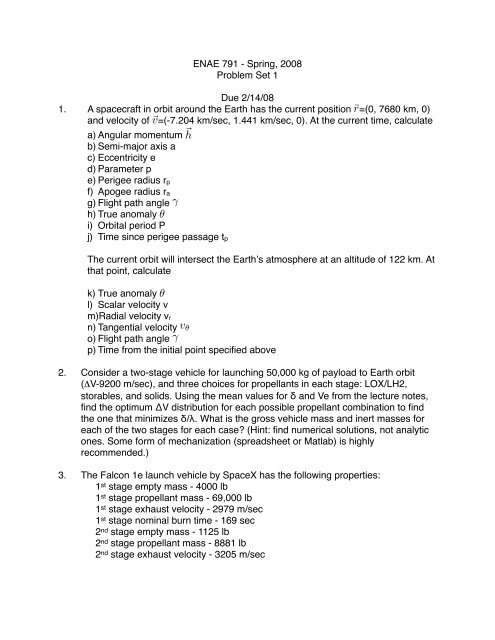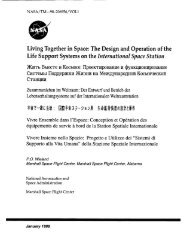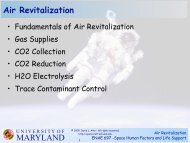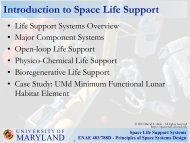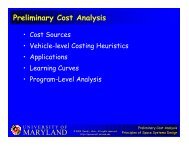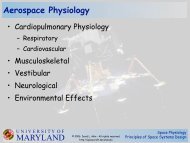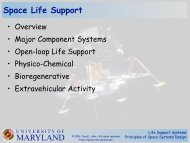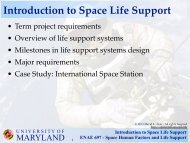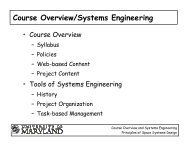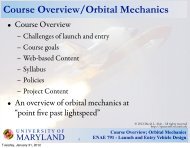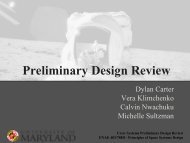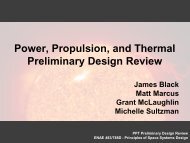ENAE 791 - Spring, 2008 Problem Set 1 Due 2/14/08 1. A spacecraft ...
ENAE 791 - Spring, 2008 Problem Set 1 Due 2/14/08 1. A spacecraft ...
ENAE 791 - Spring, 2008 Problem Set 1 Due 2/14/08 1. A spacecraft ...
You also want an ePaper? Increase the reach of your titles
YUMPU automatically turns print PDFs into web optimized ePapers that Google loves.
<strong>ENAE</strong> <strong>791</strong> - <strong>Spring</strong>, <strong>20<strong>08</strong></strong><br />
<strong>Problem</strong> <strong>Set</strong> 1<br />
<strong>Due</strong> 2/<strong>14</strong>/<strong>08</strong><br />
<strong>1.</strong> A <strong>spacecraft</strong> in orbit around the Earth has the current position r=(0, 7680 km, 0)<br />
and velocity of v=(-7.204 km/sec, <strong>1.</strong>441 km/sec, 0). At the current time, calculate<br />
a) Angular momentum h<br />
b) Semi-major axis a<br />
c) Eccentricity e<br />
d) Parameter p<br />
e) Perigee radius rp<br />
f) Apogee radius ra<br />
g) Flight path angle γ<br />
h) True anomaly θ<br />
i) Orbital period P<br />
j) Time since perigee passage tp<br />
The current orbit will intersect the Earth’s atmosphere at an altitude of 122 km. At<br />
that point, calculate<br />
k) True anomaly θ<br />
l) Scalar velocity v<br />
m)Radial velocity vr<br />
n) Tangential velocity vθ<br />
o) Flight path angle γ<br />
p) Time from the initial point specified above<br />
2. Consider a two-stage vehicle for launching 50,000 kg of payload to Earth orbit<br />
(ΔV-9200 m/sec), and three choices for propellants in each stage: LOX/LH2,<br />
storables, and solids. Using the mean values for δ and Ve from the lecture notes,<br />
find the optimum ΔV distribution for each possible propellant combination to find<br />
the one that minimizes δ/λ. What is the gross vehicle mass and inert masses for<br />
each of the two stages for each case? (Hint: find numerical solutions, not analytic<br />
ones. Some form of mechanization (spreadsheet or Matlab) is highly<br />
recommended.)<br />
3. The Falcon 1e launch vehicle by SpaceX has the following properties:<br />
1 st stage empty mass - 4000 lb<br />
1 st stage propellant mass - 69,000 lb<br />
1 st stage exhaust velocity - 2979 m/sec<br />
1 st stage nominal burn time - 169 sec<br />
2 nd stage empty mass - 1125 lb<br />
2 nd stage propellant mass - 8881 lb<br />
2 nd stage exhaust velocity - 3205 m/sec
Payload mass - 1529 lb<br />
Payload fairing mass - 300 lb<br />
a) Calculate the ΔV contributions of each of the stages. Assume the payload<br />
fairing is jettisoned at the same time as the first stage<br />
b) Calculate the change in total ΔV if the payload fairing is not jettisoned, but<br />
stays with the payload all the way to orbit<br />
c) How much payload would you have to give up to achieve the same total ΔV as<br />
in (a) with the payload fairing retained throughout the flight?<br />
d) Find the three trade-off ratios for both the first and second stage, assuming the<br />
fairing is jettisoned with the first stage.<br />
e) You wish to augment the payload by adding strap-on solid rocket motors to the<br />
first stage. You choose the Castor IV-A solid rocket motor, which has a total<br />
mass of 25,800 lb, a propellant mass of 22,300 lbs, an exhaust velocity of 2325<br />
m/sec, and a burning time of 56.2 seconds. Two of these motors will be added<br />
to the first stage and ignited at lift-off in parallel with the Falcon 1e first stage<br />
engine. Find the payload capacity of this system in order to reach the same ΔV<br />
as in (a).<br />
f) You need to put 5800 kg of payload into orbit [same ΔV as (a)]. You plan to<br />
mass-produce Falcon 1e first stages to build a modular launch vehicle to carry<br />
at least this much payload into orbit. Find the configuration (modules/stage and<br />
number of stages) which will accomplish this with the minimum total number of<br />
modules. You may use up to four stages. (To simplify this calculation, assume<br />
the payload fairing is carried all the way to orbit.)


